This gallery describes my rover adventure during the 2011 August ARRL UHF QSO party. I had planned a mix of flying to airports in different grids and roving several grids (CN87, CN97 and CN98) out of my car.
I also tried something new. The dividing line between CN88 and CN89 is 49° lattitude. But, perhaps because of errors of early surveying, the Canadian border begins at about 49° 0' 8" in both Point Roberts and along the U.S. border north of Bellingham. At 100 feet per second of latitude, there is plenty of 49° on the U.S. side, which makes activating CN89 too interesting to pass up. I decided to fly to the grass strip on Point Roberts and then hike the 1.5 miles to the CN88/CN89 boundary. This challenged me to make the radio and antenna set-up portable (backpackable) in addition to usable from the car and airplane (while on the ground, of course).
Saturday morning, I departed Harvey field in Snohomish, WA at 9:30am local time, which should have gotten me to my first grid before the 11:00am start of the contest. The weather didn't cooperate. Within a few miles I was stopped from going north by low clouds. It looked temptingly possible to get through, but after a bit of poking around for a hole, I gave up and turned around to head south to Eatonville, WA, CN85. The weather wasn't looking promising in that direction either, so back to Harvey to rove out of the car, I decided. As I headed north, it looked like it was now possible to get through the weather by diverting to the east. That worked. Once I got north of Arlington, WA, the weather cleared up considerably. I landed just before 11:00am.
I put on my backpack and hand-carried the 5 lb bundle of antenna parts, and headed north toward the Canadian border. The following photo is the pack and the antenna bundle just inside CN89 in Monument Park. The pack weighed 30 lbs, including a modified camera tripod, a Yaesu FT-857D (20 watts SSB/CW/FM on 432 MHz) and a Jetstream JT-220M (50 watts FM on 1.25 cm, purchased just a week earlier). For power, I used four 14.4 volt 3800 mAH NiMH Roomba™ replacement batteries that weighed in at 5.1 lbs. Among the antenna parts is a mast of four telescoping fiberglass poles (~1.5 lbs) that extend to almost 14'.

I had to fight blackberry brambles and find a clear spot in the this wild part of Monument Park. The following photo shows my position...just 0.86 seconds north of 49°, and less than 800' south of the Canadian border. The location was almost 200' MSL and close to the highest point on Point Roberts.
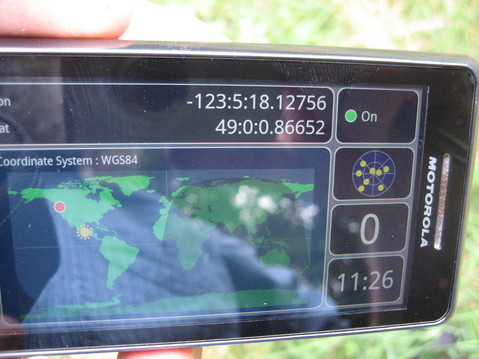
N6LB (CN88) was my first QSO on 432 MHz. Ten minutes later I worked VE7DXG (CN88) and VE7FYC (CN89) on both bands. And that was it. The replies dried up. I got two grids for three QSOs on 432 MHz and two grids for two QSOs on 223.5 MHz. Obviously, this isn't a great spot for UHF, but I did get CN89 as a multiplier. So I moved my antennas and equipment a couple hundred yards to the south to activate CN88. That was worse. I did get N6LB on 432 MHz, but everyone was off for lunch or something. I packed up for greener pastures.
I flew to Arlington, WA in CN88 and set up shop next to the commercial hangar occupied by a friend. Here is the (rather messy) pile of radios in the cockpit. (Some of those Molex connectors are connecting the four Roomba batteries sitting underneath the Jetstream.) In the plane, I used a car battery for a power supply. You can see it sitting on the floor in front of the passenger seat. An automobile--to--automobile cigarette-lighter-based charger recharged the car battery while in flight.
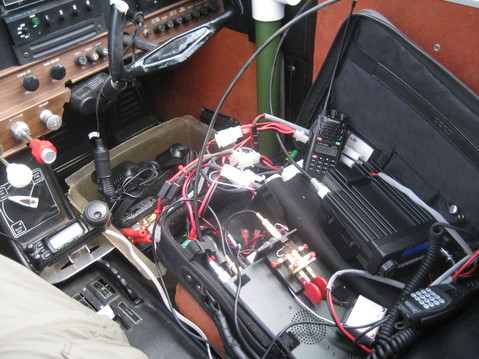
A Wouxun KG-UVD1P hand-held was used monitored 446.0 MHz FM. I did manage to catch a couple of stations this way. See that green vertical thing with a PVC T-fitting on it? That is the mast. It began life as a 31' fiberglass telescoping Kite Pole™. I removed the thin top sections to keep the whole thing under 20', which is the maximum legal height of an antenna on an airport without a permit. The base of the mast is held in a fitting that is weighed down by the battery.
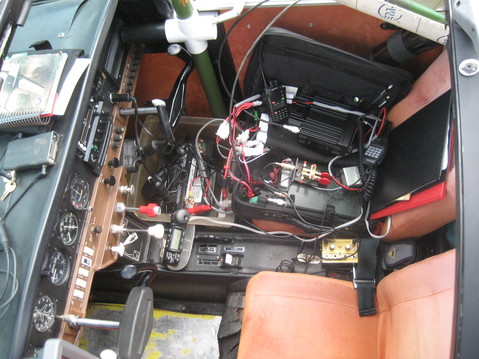
Here is the view from outside the plane. At the top of the mast is a 7-element 223.5 MHz quagi (right) and a stacked pair of 432 MHz quagis. The bracing and booms are made of aircraft-grade Sitka spruce (strong for the weight).

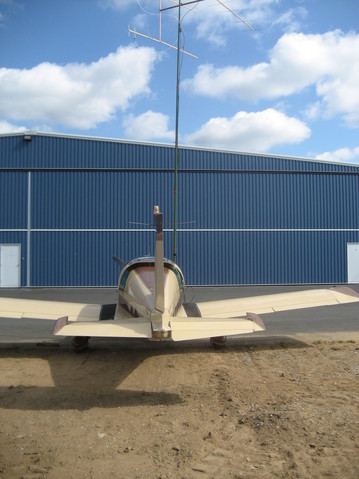
I used red Velcro™ wire-tie straps to hold the coax to the mast. It also served to slow down the mast should it start telescoping down. (Yes...this happens on occasion. It is a non-event with the Velcro™ in place..)
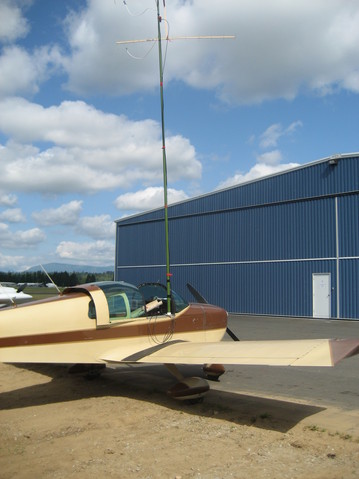
During the June and July contests, I had used RG-59 and/or RG-8x to feed the antennas. I decided to go for custom lengths of LMR-240 to reduce transmission line loss. I was a little concerned about using this stiffer coax. In fact, it was much easier to manage than RG-59/8x. It coiled up and uncoiled very nicely and quickly. For the September contest I'll use it for 6 meters and 2 meters as well.

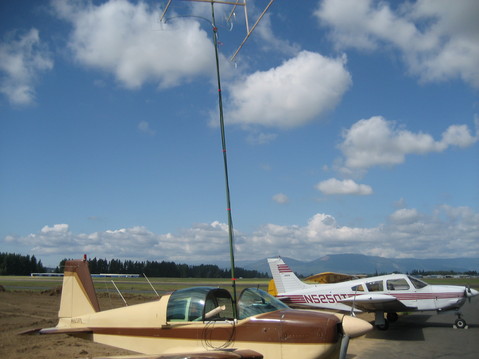
After Arlington, I flew to Eatonville, WA in CN86, somewhat tucked into the foothills of Mt. Rainier. An airborne station isn't allowed by the contest rules, but while in flight I connected an unused airplane COM antenna to the Yaesu to chat with my friend and neighbor Doug, AC7T on 446.0. He was supposed to be monitoring while he worked the NA QSO party (he wasn't). I think it was WA7BBJ who heard me calling and we had a plasant chat. One or two others (N6ZE/R) joined in.
In Eatonville, I only managed four QSOs on 223.5 MHz and three on 432 MHz. After that, I returned to Harvey field to take up roving by car. I arrived just before a series of hot air balloons were launched....
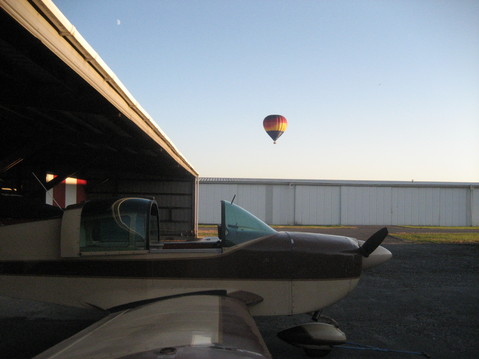
From there, I headed north and east by car for CN98, to a location I had only experienced on Google Maps and Bing Birds Eye View. I try to find unobtrusive places on top of hills, and the CN98 spot turned out to be good at 600' MSL. I got there a bit before dark. This spot yielded seven 223.5 MHz QSOs but only four 432 MHz QSOs. I used RCA connectors on the 432 MHz quagis to make assembly and disassembly quick. It seems that I didn't fully seat the connector on the top antenna of the pair. Drat!
I think it was in CN98 that someone first mentioned that my audio on 432 MHz was not sounding good--perhaps from low voltage. It wasn't low voltage. Fortunately, it wasn't bad enough to shut me down.
After that, I headed toward Redmond, to an elementary school in CN87 on a hill near my house. I didn't get set-up until after 11 pm. It seems that only Eric, N7EPD, and I are nightowls, because he is the only station I worked. (I had earlier worked N6ZE/R from CN87 while in transit to CN89.)
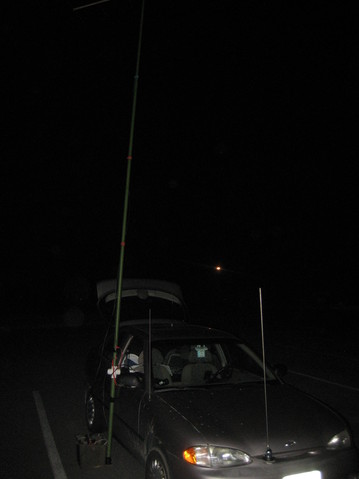
Here is the antenna cluster in the dark. Notice the slight kink in the bottom 432 MHz antenna boom? That is a hinge point, and one of the screws in the bottom antenna worked its way loose, giving the boom a slight kink. During the June VHF QSO party, the elements of the single 432 MHz quagi I was using kept poking me while flying. It was annoying enough that I left the antenna in the car during day two. So for this contest, I built a new pair of 432 MHz antennas with a very narrow hinge in the middle. To stow the antenna, I rotate down the driven and reflector loops against the boom and the fold the boom in half. It worked really well in the car, in the plane, and while hiking.
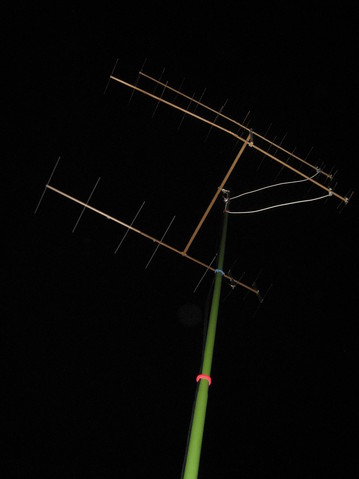
I think it was
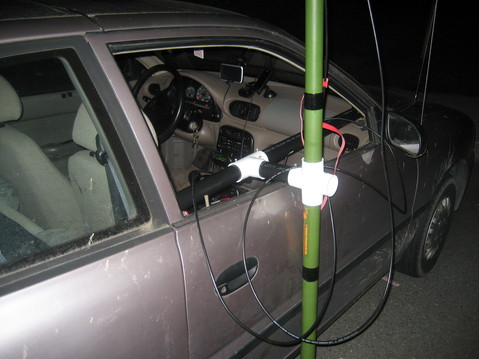
For the car I have a frame made of PVC pieces for the upper mast support. The car battery is used to hold the base of the mast, just like in the plane. The mast can be deployed very quickly.
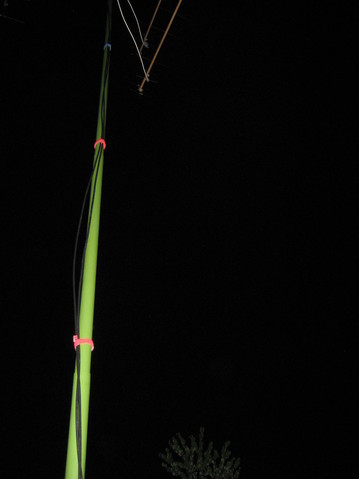
The next morning, I returned to the Elementary school and worked CN87 again. I believe it was at this point the main tuning knob fell off of the Yaesu. Fortunately, the rig was completely usable this way.
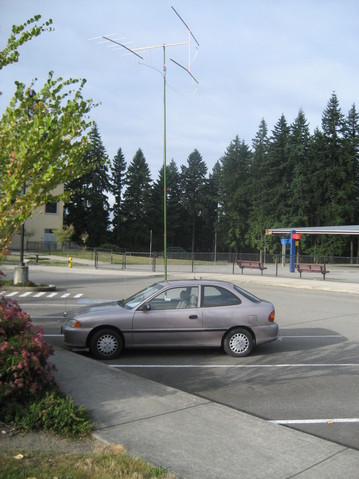
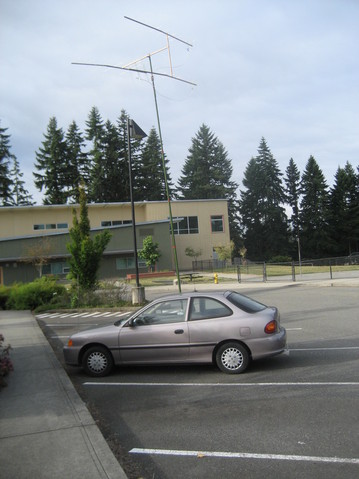
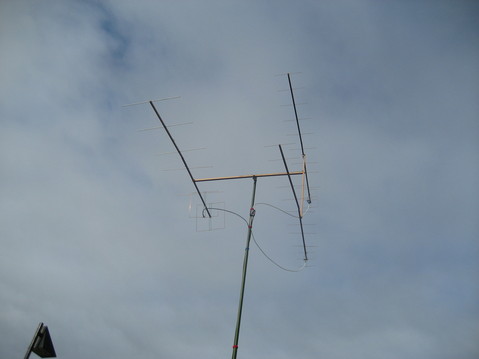
My final stop was CN97, on a 720' MSL hill in a residential neighborhood near flowing lake. A navigation "issue" delayed my arrival, so that ended up being my last stop of the contest. (I was intending to return to CN98.)
The contest was a lot of fun, and I felt like it was a success. I had incorporated some new ideas that worked out very well. I activated six grids, contacted four grids on 223.5 MHz (CN87, CN88, CN89, CN97) and five grids on 432 MHz (same plus CN85) for a total of 15 multipliers. I made 27 QSOs on 223.5 MHz and 35 QSOs on 432 MHz. That resulted in a final score of 2,790.
The next contest is the ARRL September VHF QSO party. I am already planning some antenna improvements, and I hope to be active on all four bands from 50 MHz to 432 MHz
Darryl
WW7D